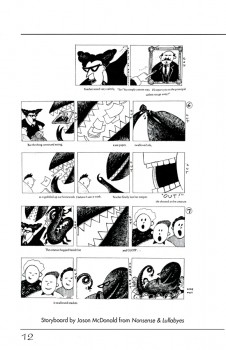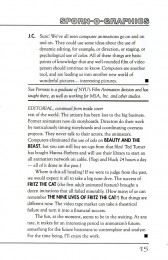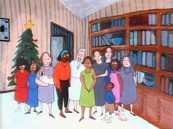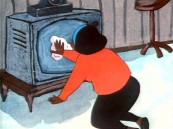Category ArchiveSpornFilms
Animation &Music &SpornFilms 08 May 2007 07:32 am
Ernest Does DeSoto
- I think music is as important to animation as any of the drawing. (Even the lack of music, to me, is a musical choice in film.)
I’ve been very lucky to have worked with some incredibly fine composers in the films I’ve done. To that end I’ve come back to work again and again with the same few composers.
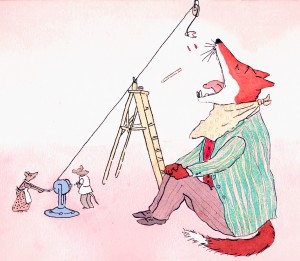 The first of those who seemed indispensible to the films we did together was Ernest Troost. We met way back on my first short film for Weston Woods. Ernest was on staff there, and we quickly became good friends.
The first of those who seemed indispensible to the films we did together was Ernest Troost. We met way back on my first short film for Weston Woods. Ernest was on staff there, and we quickly became good friends.
That first score he did for me was the delicate Rosemary Wells Morris’ Disappearing Bag. This quiet little film was successful, but it wasn’t until our second collaboration that things took off – Doctor DeSoto.
Doctor DeSoto was an Oscar nominee in 1984, and I think it was as much for the music as it was the William Steig story, or Ian Thompson’s droll reading, or any of our artwork. The film was a hit and won a lot of awards and, to this day, still gets a lot of exposure.
As we were about to go into this film, Ernest had to write a score for an slide version of the book which Weston Woods was going to distribute. I suggested he listen to Stephen Sondheim‘s score for the film, Stavisky. It was built around an infectious waltz and had a peculiar arrangement.
 Ernest came up with something that took me by surprise. It was built off Stavisky but was so totally original in its sound that I had the first little shock that I’ve always gotten when music I didn’t expect but was excited and challenged with comes into my hands. This moment is always a great surprise and one of the pure delights, for me, of filmmaking. The only other experience it resembles is when an actor gives you a line reading that is totally unexpected, one you never would hear in your own head when reading the line. This is usually the best possible reading because it indicates pure character.
Ernest came up with something that took me by surprise. It was built off Stavisky but was so totally original in its sound that I had the first little shock that I’ve always gotten when music I didn’t expect but was excited and challenged with comes into my hands. This moment is always a great surprise and one of the pure delights, for me, of filmmaking. The only other experience it resembles is when an actor gives you a line reading that is totally unexpected, one you never would hear in your own head when reading the line. This is usually the best possible reading because it indicates pure character.
Ernest’s orchestral arrangements for this music reminded me of some small cartoon cabaret in Vienna in the early 1920′s. It worked perfectly for the cartoon Brooklyn in my mind for the film’s setting.
This is the pure character of a good composer scoring your piece.
Having the luxury of this original score prior ot the animation isn’t always a luxury an Independent filmmaker is given. It costs too much. But Weston had their score for the slide film, and I saw that this was going to be a great score for my animation. I worked with that waltz tempo.
When the fox was off screen, the camera moved in time with the waltz tempo and the limited animation also hit those beats. When the villain was onscreen, there was little to no camera movement cutting the picture to the tempos. Paul Gagne, editing, certainly helped out here.
The music not only was allowed to dominate the overall film, it was enhanced by this decision.
To hear the opening theme to Dr. DeSoto click here.
Ernest Troost also wrote about a dozen Sesame Street spots for me. Many of them were songs which he wrote with Maxine Fisher who did the lyrics. Two of these spots are featured on YouTube. I like the Crocodile Smiles spot which played at Annecy and is in the MOMA collection. Pirate Plan is a good song but my graphics don’t quite work.
Here’s another spot that is built around the music. For the very low budget, it was a big track for us, but Ernest pulled it off brilliantly. Obviously, he was parodying the John Williams’ scores for Indiana Jones.
Articles on Animation &SpornFilms 01 May 2007 07:47 am
Sporn-O-Graphics #1
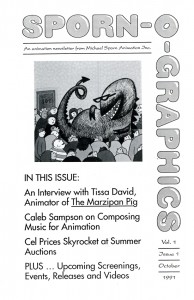 – In 1991, I’d started a small xeroxed publication that I sent out to about a thousand people on my mailing list. Basically, we were promoting ourselves by giving brief interviews and articles about the people in animation who had touched our films in some way.
– In 1991, I’d started a small xeroxed publication that I sent out to about a thousand people on my mailing list. Basically, we were promoting ourselves by giving brief interviews and articles about the people in animation who had touched our films in some way.
This first issue had as its focus the two half-hour films we’d done on poetry – Nonesense & Lullabyes: Nursery Rhymes and Nonesense & Lullabyes: Poems. These were two delightful films to work on, and I wanted to give them a bit of attention even though they were designed only for Home Video consumption. (We’re still trying to get back the rights from the now-defunct Live Entertainment to have them rereleased in dvd.)
The issue included a short interview with Tissa David who responded to questions by Esther McGowan, who edited the publication at the time. A non-animator asking curious questions.
(Click on any image to enlarge.)
The late Caleb Sampson wrote a short piece about writing film music for animation. Caleb did music for about 20 of my films.
Greg Perler gives a brief response to the differences of working at Disney’s studio as opposed to MSA. He had just moved to work on Beauty and the Beast as an Assistant Editor. (Greg recently is editing Disney’s Enchanted, due out later this year.)
The Tissa David interview:
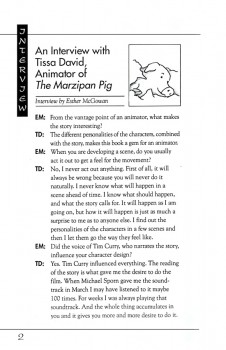 pg 2
pg 2  pg 3
pg 3
The Caleb Sampson article on music:
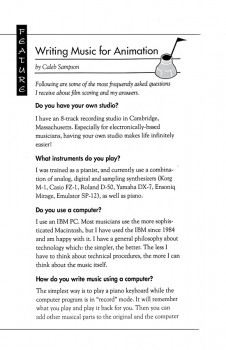 pg 4
pg 4 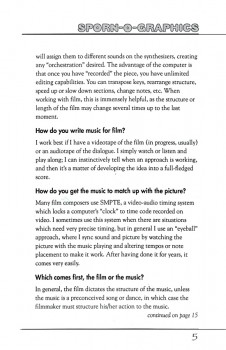 pg 5
pg 5
Stephen MacQuignon on Color Styling:
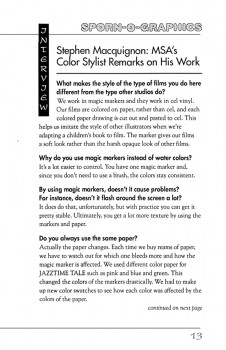 pg 13
pg 13 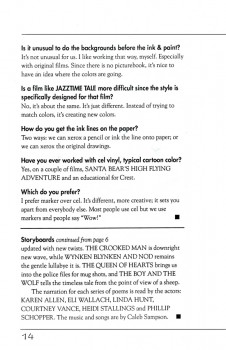 pg 14
pg 14
Greg Perler on editing here & there:
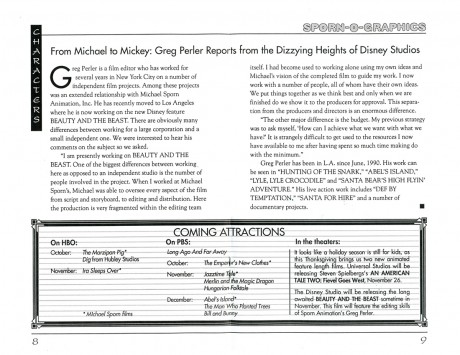 pgs 8 & 9
pgs 8 & 9
.
This issue was mailed with a cel from the half-hour shows, Nonesense & Lullabyes, and the response was a negative. Though there was no charge for the publication OR the cel, yet I received a letter back saying that the cels weren’t done with cel-vinyl, so they weren’t valuable! Oh, well. Sorry! I didn’t do that again.
Issue #4 previously appeared on this “Splog,” read it here if you’re interested.
Comic Art &Festivals &SpornFilms &T.Hachtman 24 Mar 2007 08:19 am
Hamburgers
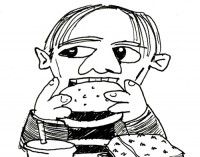 – Having finished a bunch of work for Between The Lions, the PBS show out of WGBH (a greater client can’t be found), we’ve met with a quiet period.
– Having finished a bunch of work for Between The Lions, the PBS show out of WGBH (a greater client can’t be found), we’ve met with a quiet period.
To keep busy we’ve started production on a short segment of the Gertrude’s Follies storyboard feature done years ago.
To see the history of this project go here and here.
What this has done is forced me to push cartoonist Tom Hachtman back to work on the strip. I need some new dialogue written between Gertrude and Alice, and I’d like him to do the backgrounds (only a couple are needed.) He’s a great watercolorist and airbrush artist – the real thing, not computer.
 Of course, I prefer the watercolor painting, but I’ll take whatever he’d like to do. It’s his strip and his characters; that’s his decision.
Of course, I prefer the watercolor painting, but I’ll take whatever he’d like to do. It’s his strip and his characters; that’s his decision.
Anyway, I got this card (to the left) from Tom. It thanks me for getting him back to Gertrude. (It’s my treat; the characters are so much fun drawing.)
Matthew Clinton has finished his first draft of animating the piece that’s about 2 minutes in length. Paul Carrillo has already edited up a hilarious first cut soundtrack of effects and music. All we need is the finishing parts.
It’s funny. That’s what counts.
I’m reluctant to post the strip it’s based on
(I don’t want to give up the joke, though it really doesn’t matter). It’s about Pabs eating his first hamburger – just in case any of you have seen it. (I just had a flash thinking how horrible this would have looked if we’d done it in Flash. Sends a chill through me.)
(Click images to enlarge.)
I just received in the mail a copy of the program from the Seattle Children’s Film Festival that was held in January of this year. They’d done a two program retrospective of some of our films. It was a kick having someone ask for the program; it was fun knowing that our films stay alive.
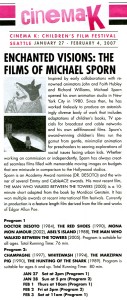 The program was enough of a success that the curator of that festival has just sent an email sayng that she is curating . . .
The program was enough of a success that the curator of that festival has just sent an email sayng that she is curating . . .
- “. . . the second annual REDCAT International Children’s Film Festival at REDCAT (Roy and Edna Disney Calarts Theatre) in Los Angeles. The festival will be comprised of a selection of the best of Cinema K: Children’s Film Festival Seattle and additional new programs.
I would like to include one of the retrospective programs we showed at Northwest Film Forum: Dr. DeSoto, The Red Shoes, Abel’s Island, and The Man Who Walked Between the Towers.”
Of course, this will be an honor, so our program will be presented at that festival in June. When I have the dates, I’ll pass them along.
All these retrospectives popping up! (There was one in Philadelphia recently, another in North Carolina, and a very big one which will be in NYC this Fall – we’ll talk about it when it gets closer.) I’m starting to feel old, but I’m loving it. (The Seattle program
from last January.)
SpornFilms &Story & Storyboards 21 Mar 2007 08:00 am
Story (board)
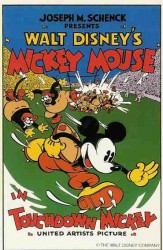 – With all this presentation of storyboards and storyboard documents, it was a real find to come upon the document Didier Ghez posted on his site, Disney History. It’s a story outline from Walt, himself, for the 1932 short Touchdown Mickey. The telling piece comes from the collection of Mark Sonntag.
– With all this presentation of storyboards and storyboard documents, it was a real find to come upon the document Didier Ghez posted on his site, Disney History. It’s a story outline from Walt, himself, for the 1932 short Touchdown Mickey. The telling piece comes from the collection of Mark Sonntag.
Obviously, there was something of a real give-and-take in the Disney films re script vs storyboard creation. Thanks to Merritt & Kaufman’s Walt In Wonderland, we saw documents like this for the silent shorts. However, I don’t remember too many treatments published for the sound shorts.
Of course, if this is the case for the short films, it’s obvious that more elaborate treatments were done for the features.
Oddly, this resembles the “scripts” written for the Larry David Show. On the set of that show the actors improvise dialogue around the breakdowns Larry David writes. The improvisation develops on its own and is pared down or built up in the editing of the final films.
 We did something like this in the making of The Little Match Girl. We’d hired Gilbert Gottfried in 1989 – long before Aladdin – to improvise the narration track in the recording studio. My writer, Maxine Fisher, had to write a one-page treatment of the Anderson tale for Gilbert to take into the recording booth. He read the treatment and kept elaborating on it making a lot of jokes as he read.
We did something like this in the making of The Little Match Girl. We’d hired Gilbert Gottfried in 1989 – long before Aladdin – to improvise the narration track in the recording studio. My writer, Maxine Fisher, had to write a one-page treatment of the Anderson tale for Gilbert to take into the recording booth. He read the treatment and kept elaborating on it making a lot of jokes as he read.
The full track was cut down to the half-hour format, and we storyboarded that. Adjusting. Adjusting Adjusting. (Gilbert Gottfried)
.
 Eventually, the overseas distributor, the video client, and HBO all asked us to get rid of the angry, yelling voice. They were financing it, so I had to, sadly, alter the track. It became a massive job since the cadences of Gottfried were so different from anyone else. 1/3 of the animation had been completed, and a lot of changes had to happen.
Eventually, the overseas distributor, the video client, and HBO all asked us to get rid of the angry, yelling voice. They were financing it, so I had to, sadly, alter the track. It became a massive job since the cadences of Gottfried were so different from anyone else. 1/3 of the animation had been completed, and a lot of changes had to happen.
We wrote a script from the old storyboard, including some of Gilbert’s jokes, and F. Murray Abraham did a great job of acting out the new narration.
(F. Murray Abraham)
In the end, I had a bit of difficulty watching the film again. It had taken so many turns. Sheila Nevins, the chief at HBO, asked me six months later if I thought this my best film. She loved it so much. I had to watch the movie again to think about it.
Stuff happens.
Sorry for that riff, but I guess this story is on my mind since we’re releasing the dvd of The Little Match Girl in companionship with The Red Shoes this coming June. We’ve been making “The Making ofs … ” for the past couple of months, and I’ve been thinking about it.
I still do think a lot about the script/storyboard/script methodology and have seen a lot of variations. I couldn’t help but point one out. I also have a lot more to say on the subject, but I’ll hold off for another time. I have a UPA storyboard by T.Hee I want to show you.

It’s interesting that I own a 16mm copy of Touchdown Mickey as well as the dvd, of course. I’ve seen the short many times and like it, but I have a lot of other B&W ones I like more. Now if it were Baseball Mickey I might feel differently.
Articles on Animation &SpornFilms 17 Mar 2007 08:34 am
Sporn-O-Graphics #4
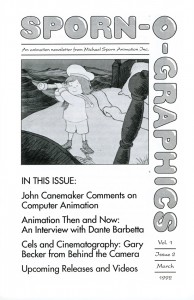 – In the early 1990′s we produced a little mimeographed magazine about animation, particularly animation within our studio. It was called Sporn-O-Graphics. About 1000 copies were sent out to a lot of people on our mailing list, no requests, no fees. We just sent them to whomever we wanted. We produced five issues of this publication, though only four were ever sent out.
– In the early 1990′s we produced a little mimeographed magazine about animation, particularly animation within our studio. It was called Sporn-O-Graphics. About 1000 copies were sent out to a lot of people on our mailing list, no requests, no fees. We just sent them to whomever we wanted. We produced five issues of this publication, though only four were ever sent out.
Since there are a couple of interesting bits in them, I’ve decided to post a couple of those interviews/articles on this site. For some of the pieces it’s re-releasing information; for others it’s fun looking back on some quaint, dated material.
In issue #4 we had two interviews:
Dante Barbetta is a first rate animator who worked at Paramount, NYIT and a lot of the commercial studios in NY. Some of his last animation was done for us on a couple of our half-hour shows.
(Click any image to enlarge.)
Denise Gonzalez, who put together this issue of Sporn-O-Graphics, interviews Dante. I wish this article had been more in-depth considering the wealth of knowledge Dante houses, but it’s good to give him any attention we can.
John Canemaker, the Oscar winning film maker, teacher and noted animation historian, is interviewed by Sue Perotto (a great animator and animation director, in her own right), John’s former student. The article focuses on the changing technology, and obviously is now dated, (it was done pre Toy Story) but I enjoyed rereading it and think you might as well.
This is Dante Barbetta ‘s interview:
 1
1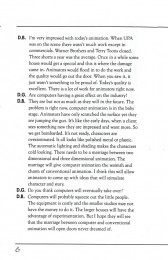 2
2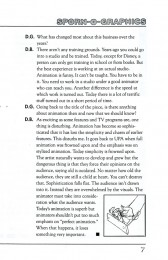 3
3
This is the John Canemaker interview:
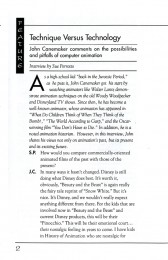 1
1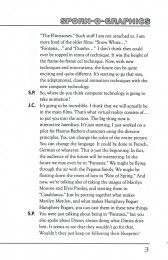 2
2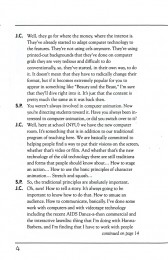 3
3
SpornFilms 11 Mar 2007 08:39 am
Jason McDonald’s Champagne Bg’s
– As you saw in yesterday’s post, Champagne, the film, had an odd birth:
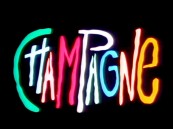 It went from the recorded documentary interview with Champagne, the girl, to improvised animation off the voice track.
It went from the recorded documentary interview with Champagne, the girl, to improvised animation off the voice track.
Jason McDonald came in to storyboard the last half of the film and bring some structure into the life of Champagne, the character.
Jason also did all the backgrounds and color models as well as coloring a good part of the film, himself.
(Click on any image to enlarge for viewing.)
Here are some of his backgrounds:
 \
\
The nuns are gathered around Champagne while she narrates her story. Jason highlighted the fake wall panelling that seems to have been everywhere in the convent. It was a good way of always letting us know where we were and at the same time giving a texture to the backgrounds.
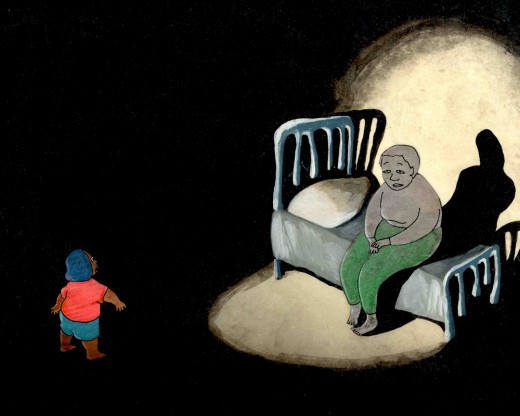
The story takes Champagne back to the point where she’s a very young child whose mother was a drug addict who didn’t take proper care of her daughter. Jason brought a lot of black into this section of the film, and it seemed appropriate.
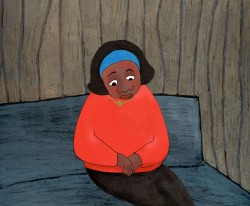
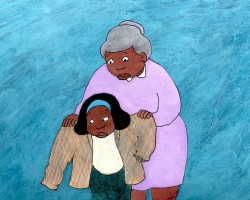
A good portion of the story takes place on the couch, as Champagne narrates. The story leads from the murder by her mother into her grandmother’s care. When the grandmother got ill, the convent took over.
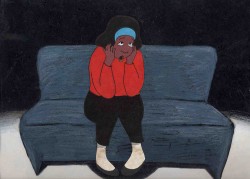
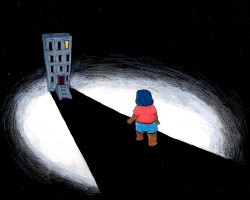
The older Champagne talks about growing up in the shadow of the prison. Many treks to and from a number of different prisons to visit her mother.

A long bus ride takes Champagne to the prison. We move out of the deep reds and into the shadowy blues of the prison. The camera was close and trucked out and then back in again. It followed the path of the bus which was a cut-out cel that was animated under the camera. The BG, itself, was about 40 inches long, and it moved quickly through the short scene.
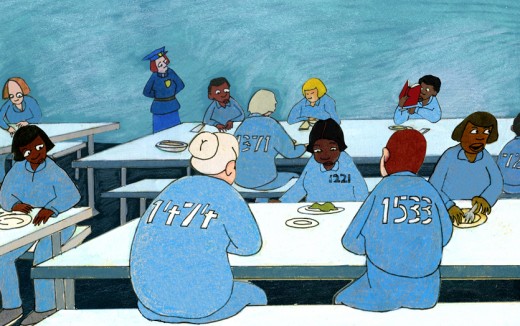
For one brief section, we leave Champagne to go into the mother’s life in prison. It’s really as viewed through the eyes of the young girl imagining her mother’s world – as informed only by what her mother has told her.

Inside the prison we take a long pan down the corridor to the cel of Champagne’s mother. There are several levels of bars moving at different speeds over this background. Blues and blacks are the predominant colors in our prison.
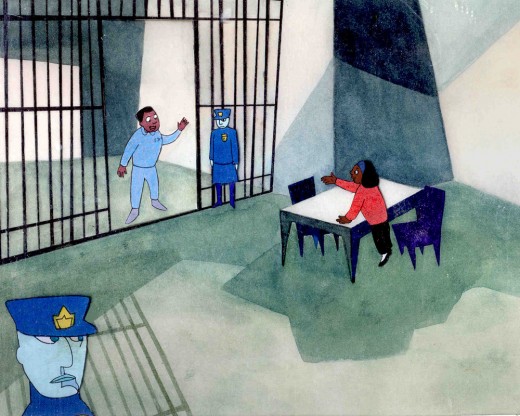
In the film, Champagne tells us what it’s like to make these visits. The entire routine is illustrated in animation from walking through metal detectors to the endless waiting in loud crowded – or empty rooms full of echoing noise. Green enters the prison surrounding Champagne. A warmth has entered the picture, though cubistic shapes separate everything into cubicles.
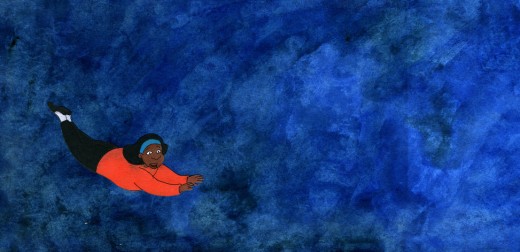
A lot of the last scenes of the film are depicted through fantasy. Champagne flies a lot moving through lots of black spiky clouds. Jason did interpret the dialogue in an uplifiting fantastic way, which worked well in depicting Champagne’s optimism. The backgrounds don’t generally get much brighter except in bits. This pan is about three times this length but a number of the overlaying clouds dominate the images.
SpornFilms 10 Mar 2007 10:26 am
Champagne, the girl
- Let me tell you about Champagne.


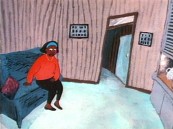
These images are frame grabs from the improvised first half of Champagne.
(Click any image to enlarge.)
- Champagne was a short film I completed in 1996. It started with Maxine Fisher, a writer who has done most of the script writing for and with me. She had volunteered to help some children, who were housed at a convent, with their reading skills. Essentially, she read to them each Saturday. These kids were being raised in the convent because their parents were imprisoned for a while. Nuns were raising them.
Champagne was one girl, 14 years old, who developed a relationship with Maxine. When she found out that Max was involved with an animation studio, Champagne asked to get a look. On her Saturday tour through my studio, she asked if I could make her a cartoon character. So I pulled out a DAT recorder and a microphone, and I interviewed her for about two hours. The end result was edited down by my editor at the time, Ed Askinazi, to 13 minutes. (Of course, I was very involved in that edit. Lots of transcripts and reworking were involved.) Eventually, we had a vocal track.
Without doing a storyboard, but having developed a character model, I started animating. I wanted to use only Champagne’s voice to get me to intuitively draw what came to mind.
Some work came into the studio, and I had to put Champagne, the film, aside. After a few months, I was about ready to go back to it. I had reached the key point where Champagne, the four year old child, had witnessed her mother killing a man and had been forced to leave her grandmother to enter the convent. The film was almost half done. We were now going to hear her talk about the future.
I asked Jason McDonald, to start a storyboard for the rest of the film. I wanted the remainder to be more structured. Jason did it, and I animated what he did – sticking faithfully to what he gave me. Then he started in on the backgrounds while I finished animating it. Eventually, he also colored a lot of it and led others in completing the art (including Champagne, herself, who was an intern in the studio – in the afternoons after her high school classes.)

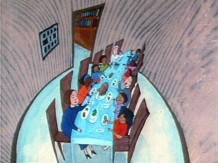
The real Champagne when Maxine first met her in the convent.
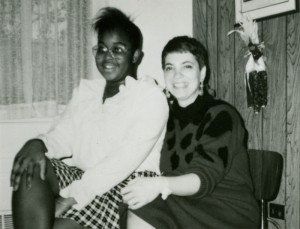

Maxine and Champagne not too long after the initial tracks were recorded.

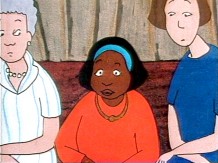
Sister Tesa, the nun who ran the convent, which was named “Our Mother’s House.”
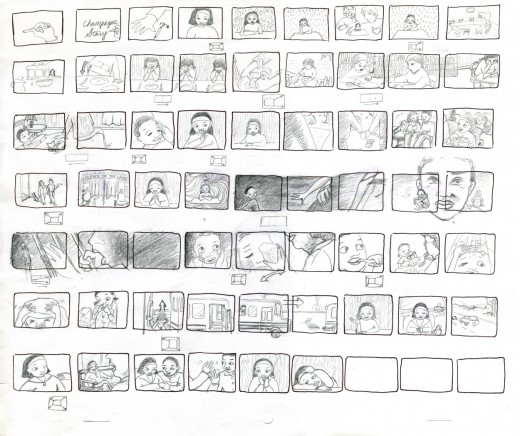
Thumbnails which were done in preparation for the storyboard for the remainder of the film.
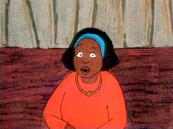
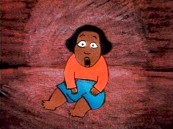

Tomorrow we’ll focus on Jason McDonald‘s backgrounds and art from the film.
SpornFilms 04 Mar 2007 07:51 am
Jason McDonald – Nonsense
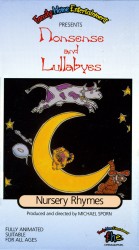 – Having presented Jason McDonald‘s first storyboard for me, the pair of films titled Nonsense and Lullabyes, I’m pleased to showcase some artwork from those two films. As I mentioned on Friday, the two films were adaptations of children’s poems. One, was subtitled “Nursery Rhymes” had anonymous authors (Mother Goose et. al.), the second “Poems” had famous authors’ poems we’d adapted.
– Having presented Jason McDonald‘s first storyboard for me, the pair of films titled Nonsense and Lullabyes, I’m pleased to showcase some artwork from those two films. As I mentioned on Friday, the two films were adaptations of children’s poems. One, was subtitled “Nursery Rhymes” had anonymous authors (Mother Goose et. al.), the second “Poems” had famous authors’ poems we’d adapted.
They were all designed by Jason as an outgrowth of the storyboards he drew. Once the boards were done and the tracks recorded, we set about layout and animation. Jason did all the backgrounds for the film using different media. Many were done with cel-vinyl, others used Dr. Martin dyes or watercolors. All used ink lines done with brush or rapidograph. Like the storyboards, these were Jason’s first backgrounds for me. They were all done on a tight budget which meant a tight schedule.
(Click any image to enlarge)
Here, then are some pieces from some of the poems:

The Creature in the Classroom
It appeared iinside our classroom at a quater after ten,
it gobbled up the blackboard, three erasers and a pen.
It gobbled teacher’s apple and it bopped her with the core.
“How dare you!†she responded. “You must leave us . . . there’s the door.â€
So begins Jack Prelutsky‘s poem. It was one of the signature pieces of the Poetry video. Linda Hunt‘s reading was half the fun, Jason’s designs the rest.

Mr. Nobody
I know a funny little man, As quiet as a mouse,
Who does the mischief that is done In everybody’s house!
There’s no one ever sees his face, And yet we all agree
That every plate we break was cracked By Mr. Nobody.
A Jack Prelutsky gem. He had to have written a good number of the poems we used; they all had charm and weight and humor. I love the sailor suit Jason gave the pointy-nosed boy.
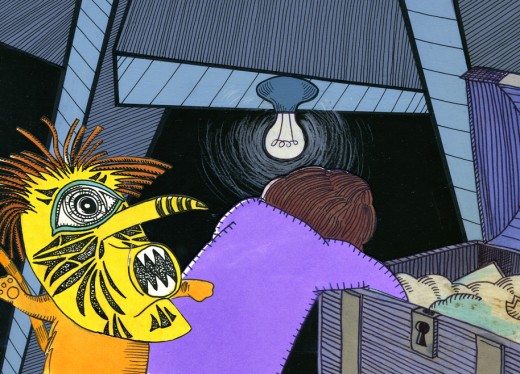
The Bogeyman
In the desolate depths of a perilous place
the bogeyman lurks, with a snarl on his face.
Never dare, never dare to approach his dark lair
for he’s waiting . . . just waiting . . . to get you.
Another Prelutsky poem, this one read with spine-tingling venom by Phillip Schopper. It was the first piece Rodolfo Damaggio animated for me. He captured the light mood underlying Jason’s board.
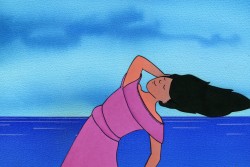
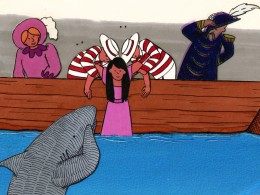
The Chivalrous Shark
He bowed in a manner most polished
Thus soothing her impulses wild.
“Don’t be frightened,” he said,
“I’ve been properly bred,
And will eat neither woman nor child.”
This was an old sea shanty that we used. It went on a bit for my taste, but Sue Perotto‘s animation and Jason McDonald‘s bright Dr.Martin backgrounds gave it life.
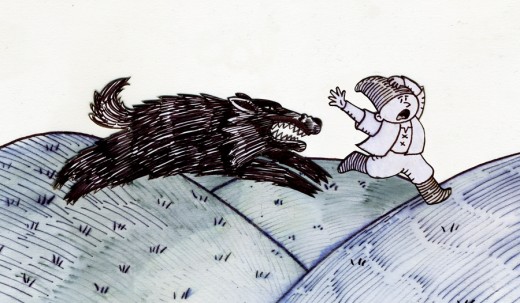
The Boy Who Cried Wolf is a victorian verse telling of this Aesop fable. The piece was on the long side, and we tried to keep it as exciting as possible. It used a style with Sharpie markers which were bled with turpentine then added some marker highlights after it dried. It was a very loose style.
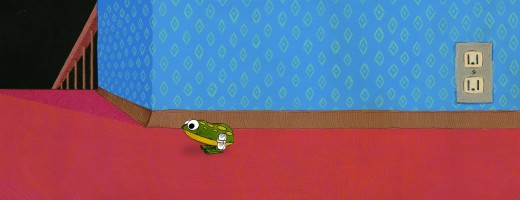
The Tin Frog
I have hopped, when properly wound up, the whole length
Of the hallway; once hopped halfway down the stairs, and fell.
Since then the two halves of my tin have been awry; my strength
Is not quite what it used to be; I do not hop so well.
This is far and away my favorite piece. Russell Hoban‘s poem is everything I wanted for this series. Jason pulled dignity out of the verse for the simple style, and Mark Mayerson did a quietly brilliant job of animating it. The character is always a tin frog, but it has so much feeling behind its mechanical motions it just tears me up every time I see it.
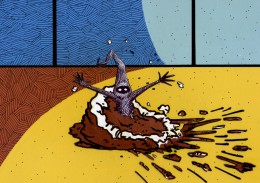
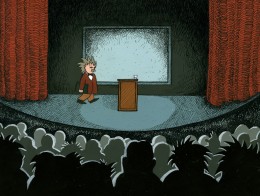
to the left: Wrimples
When the clock strikes five but it’s only four, there’s a wrimple in your clock.
When your key won’t work in your own front door, there’s a wrimple in the lock.
Jack Prelutsky continues his funny verse. A great kid pleaser. An easy author to adapt; it’s all in the words. Jason pulled more out in his board and the nice colors. He told a story that wasn’t really there.
Pictured to the right: Solomon Grundy.
Solomon Grundy, Born on Monday,
Christened on Tuesday, Married on Wednesday,
Took ill on Thursday, Worse on Friday,
Died on Saturday, Buried on Sunday,
And that was the end of Solomon Grundy.
This is an old tale that Jason developed into a lecture. Just for good measure we repeated it at twice the speed.
Turtle Soup
Beautiful Soup, so rich and green, Waiting in a hot tureen!
Who for such dainties would not stoop?
Soup of the evening, beautiful Soup!
Of course, we had to include Lewis Carroll. Caleb Sampson wrote a song of this poem sung in Alice In Wonderland. Jason gave the poem to the turtle singing inside the pot on the stove as the chef prepares him for dinner.
SpornFilms 02 Mar 2007 09:23 am
Nonsense and Lullabyes (sic)
 – Jason McDonald is an artist who started with me as a runner. Over the course of a couple of years, he worked his way up through inking, painting and coloring. He was very energetic and not at all pushy. I kept watch on his personal artwork that he’d show. His drawing style was so eccentric and charming that by the time a pair of low-budget films animating poetry – nursery ryhmes & children’s poems – I gave him the task of designing and boarding the films.
– Jason McDonald is an artist who started with me as a runner. Over the course of a couple of years, he worked his way up through inking, painting and coloring. He was very energetic and not at all pushy. I kept watch on his personal artwork that he’d show. His drawing style was so eccentric and charming that by the time a pair of low-budget films animating poetry – nursery ryhmes & children’s poems – I gave him the task of designing and boarding the films.
This Sunday I want to show off some of the images from this film, hence it made sense to give samples of his storyboard today.
This is his first real boarding job – two half hour films. I encouraged him to have fun and asked him to put in all camera move & cutting suggestions. I took some and discarded others.
I was able to get a handful of celebrities to read the poems: Linda Hunt, Eli Wallach, Courtney Vance, Karen Allen and mixed in a couple of studio regulars Heidi Stallings, Phillip Schopper to read others. One child I got was Grace Johnston. She was Barbara Hershey’s daughter in the film Beaches. What an actress she was; I had great fun working with her and cast her to do a couple more films for me.
These two poetry films went through our studio within three months. Jason took two weeks for the boards. We had an absolute smash doing them. It was fun from start to finish.
No money, but fun.
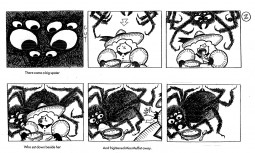
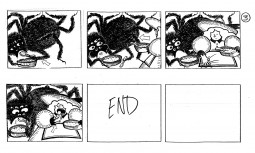
One of the films was made up of Nursery Rhymes: Mother Goose and the like. It was great seeing the take Jason would have on some of these poems. His style was very animatable. At the beginning, though, he didn’t always know how to communicate some of the elaborate camera moves in his head.
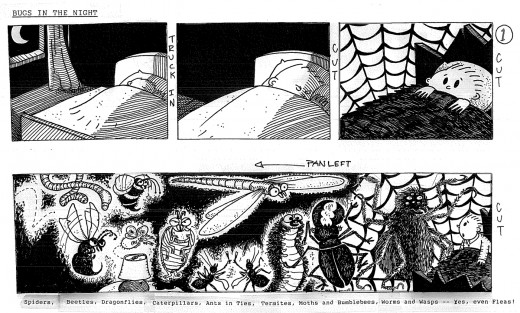
The other video was made up of poems by some famous authors. Robert Louis Stevenson, Jack Prelutsky et. al. Since we had to pay for the rights to these poems, I coaxed my writer, Maxine Fisher, to write a couple of poems. This one was inspired by a dream her brother had had, and it made for a funny piece.
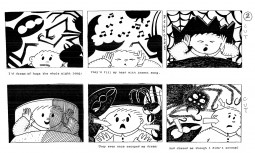
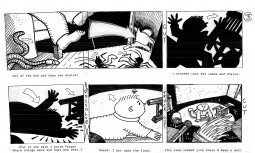
Jason is an action-adventure fan, so he was able to put some that into this piece with giant bugs chasing the boy everywhere.
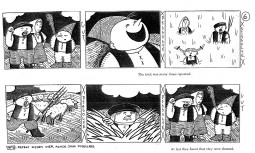
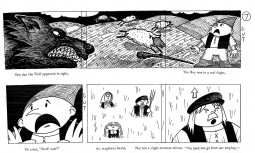
One of the longest poems ran about 4 mins. It was a version of The Boy Who Cried Wolf. It felt like I was forever animating villagers running back and forth. Because of the style we decided on, I animated the piece with a black Sharpie pen. Lots of ink bleeding through the animation paper; I had to have a two levels of paper over the last drawing.

Ultimately the piece turned out well. It looked different than many of the other pieces in the show.

Russell Hoban is one of my favorite authors. Animation fans may know him from The Mouse and His Child, a brilliant book he wrote. (The best part of that film is his invention, and they only use 2/3 of the book!) He’d also authored The Marzipan Pig which I produced.
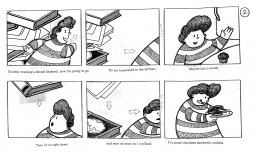
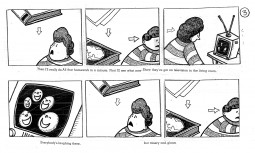
We bought the rights to several poems by Hoban. Each and every one excellent stories done economically with humor.
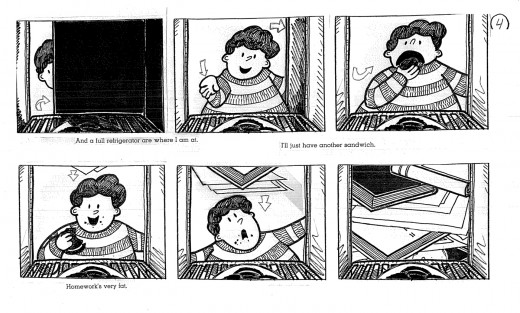
The soundtrack by Caleb Sampson required a full hour’s worth of music and several songs. With so many short pieces there was a lot of writing for him; each piece came with its own meter that Caleb had to lock into and he couldn’t fight the words of the poems. It was a tough job that never seemed to have been a challenge to him. At least, he never complained to me.
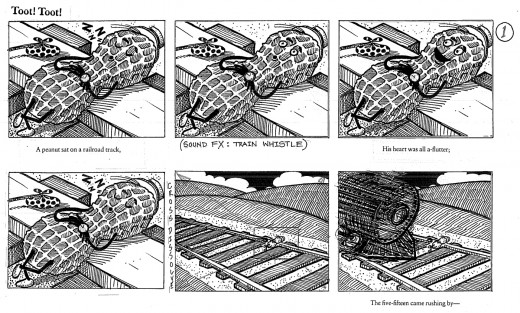
One of my favorite pieces was this less-than-a-minute poem, “Toot! Toot!”
Yvette Kaplan’s son, Randy, read it for me. I think he was eight or ten at the time. His reading never fails to make me smile.

This was a last minute addition, and it went smoothly, just like every other part of these films. I wish I had more of these projects to work on; all my days would be happy.
SpornFilms 24 Feb 2007 09:27 am
Nightingales
- Lately we’ve been preparing documentaries/extras about our Hans Christian Andersen films which will finally be released in dvd come June. These include: The Red Shoes, The Little Match Girl, The Emperor’s New Clothes and Nightingale. In making this extra material for the dvds we’ve had to prep a lot of artwork and images from the films.
Yesterday, I found when scanning in Jabberwocky for this “Splog” that the images came 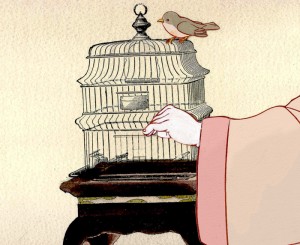 alive in the digital format. It’s much more striking than the original films. That’s also true of the artwork we’re scanning from some of these films.
alive in the digital format. It’s much more striking than the original films. That’s also true of the artwork we’re scanning from some of these films.
Nightingale was adapted from the Andersen tale, but we made a decision, early on, to base the story in feudal Japan rather than China. This allowed me to cast one of my favorite actors, Mako, as the Narrator and Emperor.
It also enabled us to adapt the beautiful art of Japan to the animation.
(Click any image to enlarge.)
The backgrounds were done by Masako Kanayama from layouts prepared by Rodolfo Damaggio and Sue Perotto. They were done in delicate watercolors with a limited palette. The characters were inked with sepia colored brush markers so that there was a dramatic thick/thin line. To expedite the production, I animated with the marker. It allowed more control in my scenes and saved the inking stage.
The following setups give an indication of the work.

This opening pan set the mood of Feudal Japan with gold paint flattening out in the filmed version. Here it looks gold as it should, rather than the brownish tint in the film. The actual Bg is quite long.

Not once did we consider looking at anime for the style. We studied the great artists of Japan of the period and looked at actual photographic reference. It never pays to study animated films for influence in preparing an animated flim. Take the inspiration from artists and real life.

The Emperor’s court took some concern. It gave us the opportunity of showing off some of our research about interiors and allowed us to show off many of our principal characters in the opening setpiece.
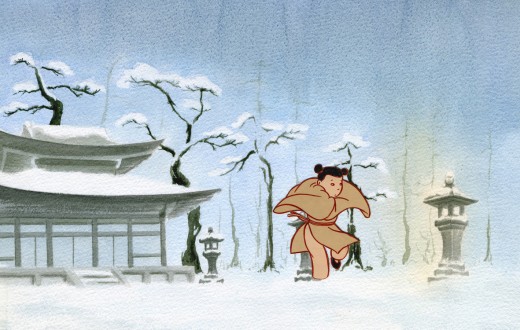
In the original there were really only two primary characters: the Emperor and the Nightingale. Since the Nightingale couldn’t talk, Maxine Fisher, who adapted the story, introduced the young girl who knows the Nightingale from the forest. She’s the intermediary between the bird and humans. She also sings all the key songs. June Angela, a fabulous actress and a wonderful soprano played the part.

She knows the whereabouts of the Nightingale and can take the Emperor’s consort to her.
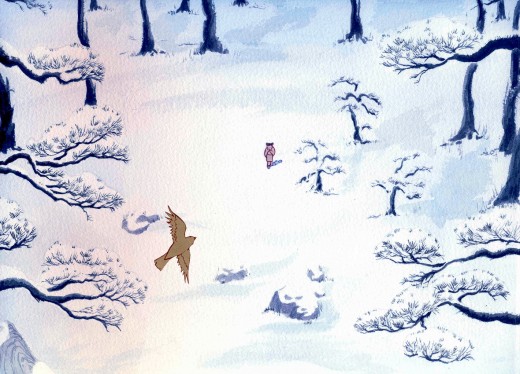
She can also console the Nightingale when she’s hurt by the Emperor.

The Emperor had to develop into a very sympathetic character over the course of the film. In Andersen’s story he learns a lesson from the Nightingale. The mechanized bird cannot live up to the real songbird. We also gave the Emperor nightmares that developed out of the Emperor’s spirituality; this was a small nod to Andersen’s outspoken Christian commentaries throughout all of his stories. We allowed the Emperor to have his own gods.

